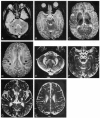Globoid cell leukodystrophy: distinguishing early-onset from late-onset disease using a brain MR imaging scoring method
- PMID: 10094363
- PMCID: PMC7056124
Globoid cell leukodystrophy: distinguishing early-onset from late-onset disease using a brain MR imaging scoring method
Abstract
Background and purpose: Our purpose was to determine the characteristic MR features of early-onset (before age 2 years) versus late-onset (after age 2 years) globoid cell leukodystrophy (GLD).
Methods: Thirty-four brain MR images in 22 patients with GLD were reviewed. A severity score (0 to 32), based on a point system derived from the location and extent of disease and the presence of focal and/or global atrophy, was calculated for each examination.
Results: Of the 22 patients, three were asymptomatic and 19 were symptomatic. Ten patients had early-onset disease, whereas nine had late-onset disease. MR images of all patients showed abnormalities. In the early-onset group (n = 10; mean maximum MR score, 8.1; range, 3-18), 90% had pyramidal tract involvement, 80% had cerebellar white matter involvement, 70% had deep gray matter involvement, 60% had posterior corpus callosal involvement, 50% had parietooccipital white matter involvement, and 40% had cerebral atrophy. Serial MR imaging in four of these patients revealed progressive disease. In the late-onset group (n = 9; mean maximum MR score, 5.6; range, 4-10), 100% had pyramidal tract involvement, 100% had parietooccipital white matter involvement, 89% had posterior corpus callosal involvement, and none had cerebellar white matter involvement, deep gray matter involvement, or cerebral atrophy. Serial MR imaging in one patient with late-onset GLD did not reveal any change. A spectrum of findings was observed in the three patients who were asymptomatic.
Conclusion: Cerebellar white matter and deep gray matter involvement are present only in early-onset GLD. Pyramidal tract involvement is a characteristic finding in both early- and late-onset GLD. This scoring method for brain MR observations will assist in the objective assessment of the impact of hematopoietic stem cell transplantation in patients with GLD.
Figures






References
Publication types
MeSH terms
LinkOut - more resources
Full Text Sources
Medical
